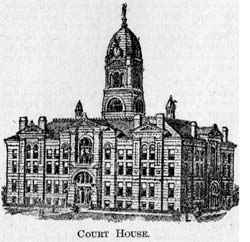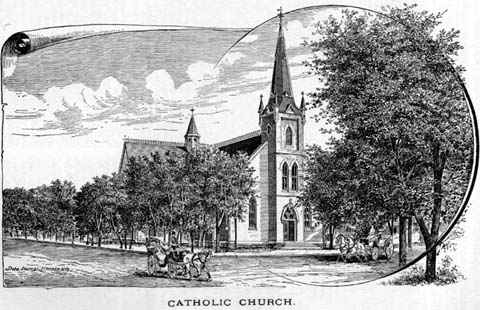NEGenWeb Project
Resource Center
On-Line Library
The university library was commenced with 1,000 volumes when the university was founded. There are now nearly 17,000 most economically selected and most admirably adapted to college use. Nearly 200 periodicals, American and European are taken. The library wants a new building very badly, the present one being far too small.
 The library of the State Historical Society along some lines of information is very complete; 25,000 publications and manuscripts on our colonial history are exceedingly good. In 1886 it had only 150 volumes, now it has nearly 5,000.
The library of the State Historical Society along some lines of information is very complete; 25,000 publications and manuscripts on our colonial history are exceedingly good. In 1886 it had only 150 volumes, now it has nearly 5,000.
Lancaster County court house completed in 1889 at a cost of $200,000, in point of architectural beauty, even surpasses the capitol building. It is 100x150 feet in ground area, and is 145 feet from the base of the building to the top of the dome. There are three stories and basement, all with very high ceilings. The facings are of Berea stone. The hallways are flagged, and the court rooms are frescoed in a beautiful manner. The structure is perfectly fire-proof, and supplied throughout with every essential becoming an institution of this magnitude.
Post-office receipts are very generally a correct barometer of a city's business. The following table points to Lincoln's rapid growth.
TOTAL RECEIPTS.
| 1875 |
$10,157
|
| 1876 |
12,497
|
| 1877 |
14,537
|
| 1878 |
19,315
|
| 1879 |
23,990
|
| 1880 |
25,563
|
| 1881 |
31,882
|
| 1882 |
35,642
|
| 1883 |
38,571
|
| 1884 3 cent stamps goes out of use |
36,066
|
| 1885 |
40,507
|
| 1556 |
47,269
|
| 1887 |
56,000
|
| 1888 |
61,887
|
| 1889 |
70,487
|
| 1890 |
76,863
|
| 1881 |
80,162
|
The government building completed in 1879 cost $214,000.
In 1891 there was filed with the county clerk of Lancaster thirty-eight articles of incorporations representing a capital stock of $5,487,000.
POPULATION.
| 1867 |
500
|
| 1870 |
4,500
|
| 1875 |
7,300
|
| 1880 |
15,600
|
| 1885 |
22.800
|
| 1890 |
55,491
|
Since 1890 the city has added steadily to her population and it is supposed there are now 60.000 people living within her corporate limits.
Lincoln is the heart of Nebraska's railroads and the center of the Burlington system which has so honeycombed the State.
The magnificent and almost unequalled railroad advantages of Lincoln may be concisely summarized as follows:
1. Lincoln is advantageously situated on five great systems of railroad, viz: The Burlington, Union Pacific, the Rock Island, the Northwestern, and the Missouri Pacific. These roads have a mileage of 21,771 miles west of the Missouri River and 5,440 miles in Nebraska.
2. These four great systems give Lincoln eleven radiating lines of road as follows: Burlington six, Union Pacific two, Rock Island, Northwestern and Missouri Pacific one each.
3. Lincoln is the center of the Burlington's extensive system of roads west of the Missouri River; and this system is so constructed that seven-eights of all the merchandise that comes into the State and of all the products of the west hauled east over the Burlington's 2,213 miles in Nebraska and 884 in Kansas, Colorado, Wyoming and South Dakota, passes through Lincoln.
4. On the five railroad systems entering Lincoln they run every twenty-four hours fifty-seven passenger trains and forty-eight regular freight trains. The extra freights number nearly as many as the regulars, making a total of about 150 trains entering and leaving the city daily.
5. Lincoln is on the through lines of the Burlington and the Rock Island from Chicago to Denver. She communicates with Chicago by through trains over the Burlington, Rock Island and Northwestern, reaching Chicago in less than eighteen hours. She reaches Denver by through trains over the Burlington, Union Pacific and Rock Island. She reaches Kansas City and St. Louis by through trains over the Missouri Pacific and the Burlington.
6. From points on nearly all the Burlington lines, and on much of the lines of the other roads business can be done personally or by letter in twenty-four hours less time with Lincoln than with Omaha. St. Joseph or Kansas City. This is because Lincoln is enough nearer to these points to allow the transaction of business on the day the letter or the merchant leaves his home.
What the future holds in the way of ad-
| 218 |
NEBRASKA'S ENTERPRISING CITIES.
|
|
ditional railroads partakes so much of the character of the inevitable that the pointing it out can hardly be called speculation.
The F. E. & M. V. road (Northwestern) must build west to some point on its Superior branch; the Missouri Pacific must have a connection with its Crete and Hastings branches. The Rock Island must make for itself a southern connection by closing up the gap between its Nebraska line and Topeka, and also shorten its Denver route by building from Lincoln to Fairbury or Nelson. These are developements (sic) that will be the legitimate and inevitable outgrowth of the present situation. Besides these there is little room for doubt that the Chicago, Milwaukee & St. Paul will enter Lincoln at an early date either over a line of its own, or, more probably by traffic arrangements with the Rock Island.
 THE BURLINGTON ROAD.
THE BURLINGTON ROAD.
More than any other great railroad system the Burlington seems to have been built with an especial eye to the business to be derived from agriculture. The management would seem to have calculated wisely on the future developments of a country which afforded scarcely any business when it was first entered by the road and to have foreseen that each succeeding year would bring a larger business--a business that will be undiminished when mines are exhausted and forests have been cut away. With this end in view that territory was selected which promised to be the richest in agricultural products, and the inevitable result was that Nebraska was selected as the Burlington's especial field of operations. Not only is this ruling principle seen in the preemption of Nebraska by the Burlington, but in its selections of its routes within the state for almost invariably, instead of following the easy grades of the streams, lined on each side by hills and waste land, it has selected the middle of the rich table-lands where for hundreds of miles along its right of way scarcely an acre of rough or unproductive land is to be seen.
The result of this course is that the volume of this road's business is increasing immensely from year to year; and as Lincoln is the center of the system west of the Missouri the stream of products of the farm pouring east through Lincoln and of supplies flowing west through Lincoln and from Lincoln pays every year a greater amount of toll to this city.
The round house, offices and yards of the Burlington in this city give employment to about 1,000 men, including the train crews which have their residence here.
HAVELOCK.--This suburb is where the great shops of the Burlington Railroad are located. These shops will be, when the present plans are completed, the largest west of Chicago. The plans call for fourteen buildings covering 100 acres. At present three of these have been finished at an expense of $300,000. They comprise a machine and construction shop 100x140 feet; blacksmith and boiler shop 80x200 and a power house 55x140. The smoke stack is 125 feet high, the water stand pipe 100 feet high and fourteen in diameter; 800 men are at present employed and when all the machinery is in there will be 1,000.
Two hundred acres of ground have been set aside here for freight transfer and will be entirely shut out from public communication.
The last year has been one of very little activity in railroad building. Most of the Burlington's extensions have been outside the state but in territory directly tributary to Lincoln. These have been as follows: On the Deadwood line from Roachford to Deadwood, 23 1/2 miles; on the Hot Springs line from Minnekahta to Hot Springs, 13 miles; on the Newcastle line from Reno westward to Gillette, 48 miles; on the Culbertson extension from Beaverly to Wauneta, 23 1/2 miles. Total 108 miles.
The Burlington has 3,097 miles of railroad west of the Missouri River and 2,213 miles in this state. There are practically three parallel lines running entirely across the southern third of the state from east to west, and connected by a system of north and south branches that gridiron the whole territory. Three nearly parallel lines have been started through the north half of the state in a northwesterly direction, one of which has been extended into Black Hills and into the coal and oil fields of Wyoming.
On these lines thirty-three passenger trains, thirty regular freight trains and about as many extras move into and out of the city daily; making a total of about 100 trains in and out every twenty-four hours.

|
|
|
|
|
© 2002 for the NEGenWeb Project by Pam Rietsch, Ted & Carole Miller
|
 The library of the State Historical Society along some lines of information is very complete; 25,000 publications and manuscripts on our colonial history are exceedingly good. In 1886 it had only 150 volumes, now it has nearly 5,000.
The library of the State Historical Society along some lines of information is very complete; 25,000 publications and manuscripts on our colonial history are exceedingly good. In 1886 it had only 150 volumes, now it has nearly 5,000. THE BURLINGTON ROAD.
THE BURLINGTON ROAD.


